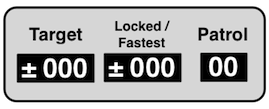
Moving mode radars also display radar measured patrol vehicle speed.
Typical Moving Mode Radar Display

| Configurations and Modes |
Microwave radars come in two basic configurations, hand held and mounted, with various modes and options.
| Hand Held | Fixed Mounted | |
|---|---|---|
| Modes | Stationary Mode Moving Mode optional* |
Stationary and Moving Modes |
| Power Source | Internale Batteries and/or Vehicle Battery DC plug. |
Vehicle Battery |
| Remote Control | Option | Standard - Wired or Wireless |
| Antenna Location | Antenn mounted inside vehicle. Outside Antenna optional. |
|
| Second Antenna | Optional Front and Rear Antennas | |
| Radar VSS cable option | Vehicle Speed Sensor (VSS) used for detecting patrol speed shadowing and speed bumping. |
|
| Video cable option | Superimposes radar measured speed(s) on patrol vehicle video system. |
|
| Frequency Band | X Band, K Band, or Ka Band | |
| Transmissions | Continuous and/or Instant On | |
ANTENNA MOUNTING
Fixed mounted antennas should be located as high as possible and must be aligned to patrol vehicle direction of travel. Front mounted antennas should be directly facing the front of the vehicle, rear antennas facing aft. Any misalignment may result in high target vehicle speed readings in moving mode.
Front antennas are usually located on the dash board, right, middle or left. Rear antennas are mounted on the rear dashboard or one of the upper corners of the back windshield. Outside antennas are mounted in any of the upper corners by the passenger compartment roof.
VSS CABLE
The VSS cable option allows the radar to compare radar measured patrol speed to the vehicle speedometer. If radar and vehicle measured speeds do not closely match, generally due to patrol speed shadowing or bumping, the radar stops processing target echoes until the speeds match. This prevents the radar from displaying what would be a high target vehicle speed reading.
PATROL SPEED BLANKING
All moving radars are equipped with a Patrol Speed Blanking switch. Occasionally the ground echo patrol speed measurement gets stuck on off angle reflections forcing a low measured patrol speed. The patrol speed blanking switch breaks then reestablishes lock and usually corrects the problem.
RADAR MODES
| Stationary Mode | Moving Mode | |
|---|---|---|
| Standard | On-coming Traffic | Opposite Direction Traffic |
| Optional | Receding Traffic | Same Lane/Direction Traffic |
| Optional | Fastest Target Mode Radar displays strongest and fastest echo speeds. |
|
| Displays, Status and Fault Indicators |
SPEED WINDOWS
Speed is sometimes displayed with a plus "+" or minus "-" sign. A plus sign indicates displayed speed is from an approaching vehicle, a minus sign indicates vehicle receding.
Some hand held radars use a single speed display window for measuring and locking speed readings. Some models have two speed windows, one for real time speeds and the other for locked speeds. The locked speed window is also used to display fastest vehicles for radars that can display strongest and fastest targets.


SPEAKER
Most radars have a speaker allowing the operator to hear an audio tone proportional to the Doppler frequency of the target vehicle. The faster the target vehicle the higher pitch the tone. Some models can sound an alert beep when measured speed exceeds a preset limit.
Status Indicators
A radar may have separate status light indicators, or may display status in the speed window.
| Status | Mode |
|---|---|
| XMIT | Transmitting |
| STBY | Standby |
| Mov | Moving Mode |
| Sta | Stationary Mode |
| SL | Same-lane moving Mode |
| Fast | Fastest Target Displayed |
| Lock | Target Speed Locked |
| Fault | Condition |
|---|---|
| RFI | Radio Frequency Interference |
| BIT Err | Built-in Error |
| Xmit Err | Transmitter Frequency or Power problem |
| Low Volt | Low Voltage condition |
| Motorcycle Operation |
Most motorcycle radars are hand held models intended for stationary operation only. The motorcycle should not be running and all radios, voice and data, should not be transmitting. When a violation is measured the radar is placed in STANDBY or OFF mode, put in a secure place such as a holster mount on the frame, and the operator starts the motor and proceeds after the speeder.
A few radar models physically mounts the radar to the motorcycle frame. The antenna beam is fixed making stationary operation more difficult to set up, but makes moving mode operation possible. There are a number of problems operating fixed mounted traffic radar from a moving motorcycle.
Police motorcycles have stiffer suspensions and a rougher ride than a four wheeled vehicle. Additionally motorcycles have much more engine vibration. The bumpier ride and engine vibrations can cause a speed bumping or batching effect and false readings. Also the antenna is mounted relatively close to the ground and favorable to patrol speed shadowing resulting in high target speeds.
Radar operation from a moving motorcycle is not CPL approved.
